Three essential tools for measuring and analyzing QA performance are used in call centers– CQA scores, QA scorecards, and dashboards. For call center professionals aiming to improve operational efficiency and provide exceptional customer experiences, grasping these tools' distinct roles and nuances is crucial. This blog will compare these three tools and demonstrate how each contributes to optimizing performance and elevating overall efficiency.
There is often a lot of confusion around these three terms, and they are commonly mistaken for each other. However, the Customer Quality Assurance (CQA) Score, QA Scorecard, and the Dashboard are distinct, although they share a common purpose: all three are used for quality assurance purposes in call centers.
What Is Quality Assurance in Call Centers?
Quality assurance (QA) refers to a process used to ensure and maintain the highest standard of service delivery and customer interactions. It involves monitoring and evaluating agents' performance through various metrics, such as call monitoring, customer feedback, and adherence to established procedures.
Quality assurance's primary goal is to identify improvement areas, provide constructive feedback to agents, and implement strategies to enhance overall customer satisfaction. QA is not a standalone process; it contributes significantly to broader performance metrics, such as First Call Resolution (FCR), Customer Satisfaction (Csat), and Average Handle Time (AHT), among others. In fact, these metrics are sometimes included in QA scorecard.
Effective tracking and measurement of performance metrics help call centers to:
- Identify areas of excellence and gaps in service
- Derive insights into customer behavior and responses
- Evaluate agent effectiveness and identify training or coaching requirements
- Predict future trends and prepare accordingly
CQA scores, QA scorecards, and dashboards are all used to track and measure performance metrics. Now, let's look at each of these tools individually.
What Is the CQA Score?
The customer service QA (CQA) score is a metric used to assess the quality and effectiveness of customer service interactions within a call center. It is typically derived from evaluations based on predetermined criteria, such as adherence to scripts, resolution of customer issues, communication skills, customer satisfaction (Csat), and overall service delivery.
The CQA score is assigned through a systematic review of interactions, including phone calls, chats, emails, or any other communication channels used for customer support. Quality assurance teams or managers assess these interactions against established standards to measure how well agents meet the desired service levels and customer satisfaction goals.
A higher CQA score indicates that the agent has successfully met or exceeded the defined criteria, providing a positive customer experience. On the other hand, a lower score may suggest areas for improvement in agent performance, training, or processes to enhance overall customer service quality.
An excellent example of a CQA Score is the mySQM™ QA Score, evaluated out of 100 points, with 85% of points customer-focused and 15% of points organization-focused. The mySQM™ QA Score allows for standardized measurement, enabling tracking and benchmarking at agent and call center levels within or against other companies.
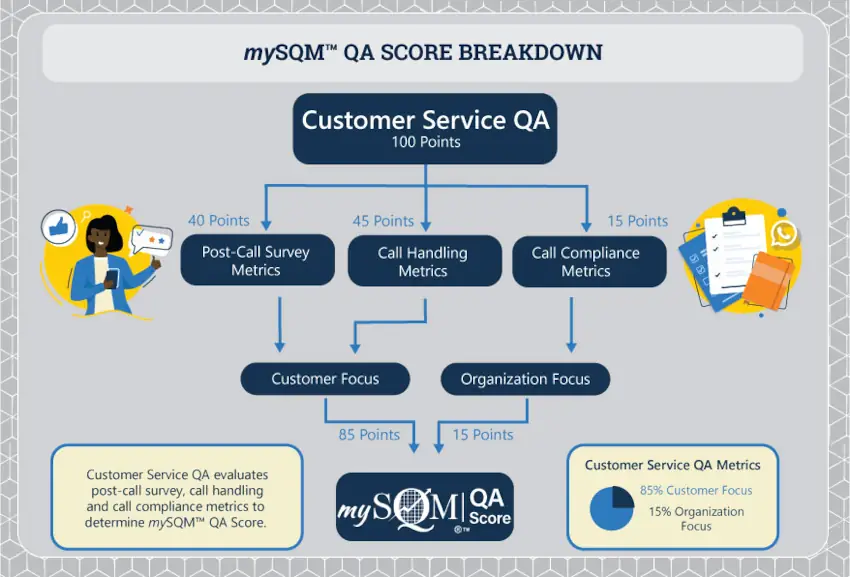
The total mySQM™ QA Score is based on three categories (i.e., post-call survey-40 pts, quality assurance-45 pts, call compliance-15 pts), and the total QA score is based on 100 points available. 85% of the points are weighted toward customer service delivery and 15% toward call compliance. mySQM™ QA Scoring range is the following: Great: 100 Points, Good: 90-99, Average: 70-89, Needs Improvement: 50-69 & Unacceptable: 0-49.
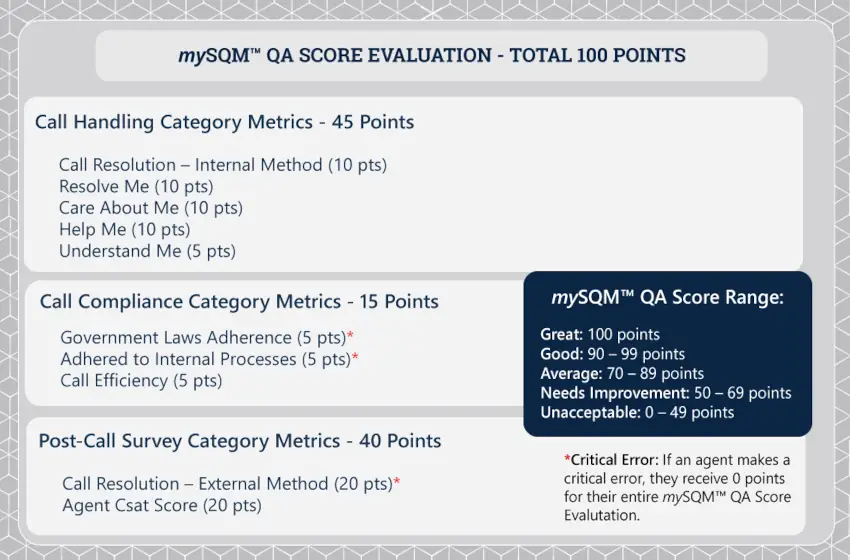
The CQA Score is a number, usually between zero and one hundred. This number represents the agent's performance. The higher the number, the better the agent's performance. This number is calculated using a QA Scorecard.
What Is the QA Scorecard?
A QA Scorecard is a performance evaluation tool for call center agents. It's designed to assess the capability and efficiency of an agent in line with pre-established parameters. Its primary purpose is to ensure agents adhere to company guidelines and deliver optimal service. It also serves as a performance analysis tool that assists managers in identifying areas of improvement and training needs.
Every customer call is a distinct situation that requires agents to adapt. A well-designed CQA scorecard empowers your agents to provide excellent customer service tailored to each unique situation.
Key Elements and Categories Included in a QA Scorecard
A well-crafted QA scorecard encompasses multiple dimensions of an agent's performance. Key elements typically included are:
- Call handling: Assesses agent's skills in managing the call flow effectively.
- Communication skills: Checks the agent's communication's clarity, accuracy, and comprehensibility.
- Adherence to guidelines: Ensures the agent follows government laws and internal regulations.
- Call resolution: Evaluates an agent's ability to address and resolve customer issues promptly and satisfactorily.
How Is the QA Scorecard Used to Assess Agent Performance?
The QA Scorecard is used systematically to evaluate and score agent performance. Each call handled by the agent is scored against the established metrics in the scorecard. Collectively, these scores provide an overarching picture of an agent's strengths and weaknesses. Managers, in turn, can use this information to provide targeted training, coaching, and support to enhance agent performance. It is the backbone of any call center's performance management and quality assurance.
A great representation of a QA Scorecard is the mySQM™ QA Scorecard. The mySQM™ QA scorecard offers valuable CX insights and guidance, enabling agents to deliver excellent customer service through appropriately weighted metrics. Below is an example of the mySQM™ QA Scorecard with a proven track record for benchmark performance and improving Csat.
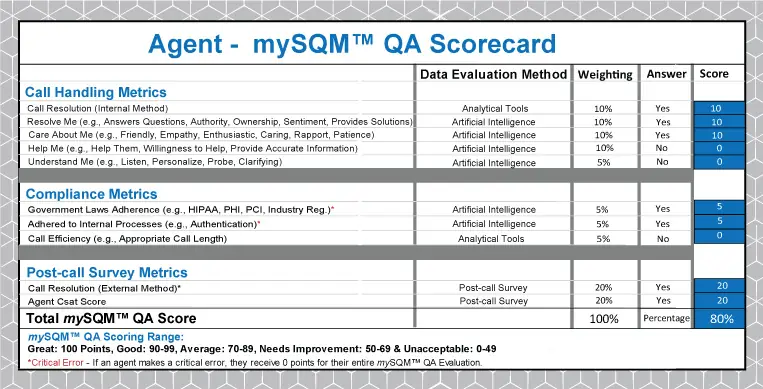
Traditional QA uses only one rater (e.g., QA evaluator or supervisor) approach to provide agent feedback. In addition, the most effective Customer Service QA 360-Degree Feedback approach provides agents with insights based on behaviors they demonstrated on a call that multi-rater data evaluation methods such as analytical tools, artificial intelligence, and post-call survey, which is better than just one rater.
For agents to understand and improve their CQA Score, they must be able to view their results clearly and straightforwardly. The best method for doing so is to use a dashboard. Dashboards offer real-time feedback, allowing agents to benchmark their performance against other team members and identify coaching opportunities.
What Is the Dashboard?
'Dashboard' refers to a visual interface that displays important metrics and information that reflect the call center's performance. The primary purpose of the dashboard is to offer an at-a-glance view of the key performance indicators (KPIs) and other relevant information. It tracks CQA Scores, call volumes, service levels, handle times, and several other parameters that comprehensively depict a call center's functioning.
A dashboard aims to simplify complex data sets and present them in a digestible format. This gives supervisors and agents easy access to a real-time overview of their performance. By identifying trends and tracking performance over time, dashboards help make data-informed decisions that can enhance efficiency, boost agent productivity and agent accountability, and ultimately elevate customer service.
The dashboard is the perfect way to display Customer Service QA data in a visual and easily understood fashion. Agents often improve their CQA performance by viewing the CQA dashboard performance and benchmarking it to other agents on their team or call center.
For example, SQM's Agent Dashboard includes call resolution and Csat gauge chart widgets that provide performance score insights and action alerts widgets to identify service recovery and coaching opportunities. Also, the agent dashboard shows how they rank for Csat and call resolution; out of all the features of mySQM™ Customer Service QA Software, customers like the dashboard the best.
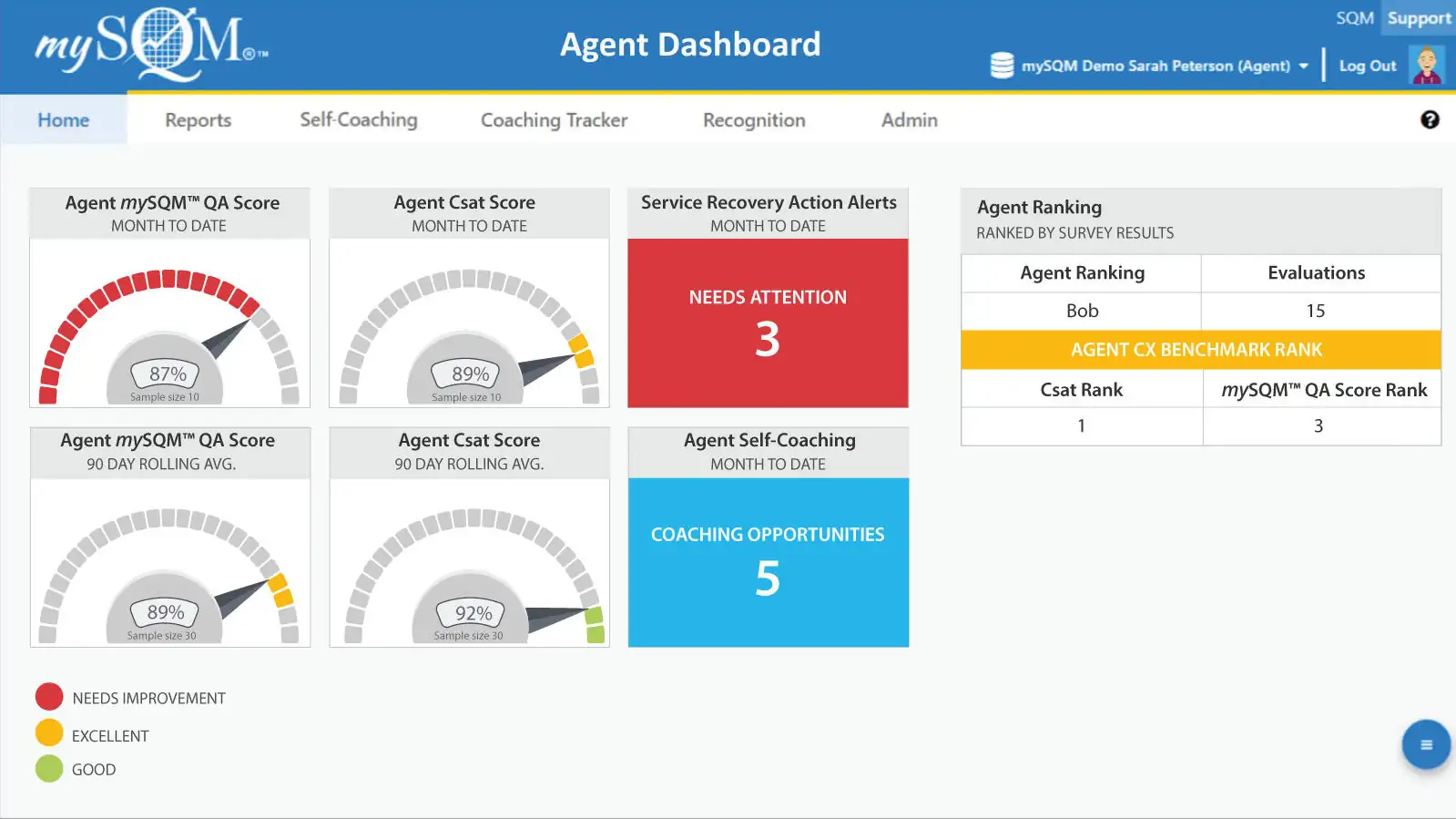
Comparing the CQA Score, QA Scorecard, and the Dashboard
The first step towards understanding these valuable call center tools is recognizing the unique role each plays in performance and quality assurance.
Differentiating the Roles and Purposes of Each Tool
CQA Score assesses the quality and effectiveness of call center customer service using criteria like script adherence, call resolution, communication skills, and overall service delivery. A CQA Score is a number, typically between 0-100, positively correlated with agent performance.
On the other hand, the QA scorecard is used to calculate the CQA score. The QA scorecard is a detailed breakdown of performance metrics such as call handling, communication, and adherence to laws and regulations. Each call handled by the agent is scored against the established metrics in the scorecard.
The dashboard, however, serves a broader function. It provides an at-a-glance view of real-time and historical performance data across multiple metrics. Dashboards include information about calls handled, service level, average handle time, and more. They often have customizable viewing options, allowing management to focus on specific data as needed. The dashboard is the perfect way to display CQA data in a visual and easily understood fashion.
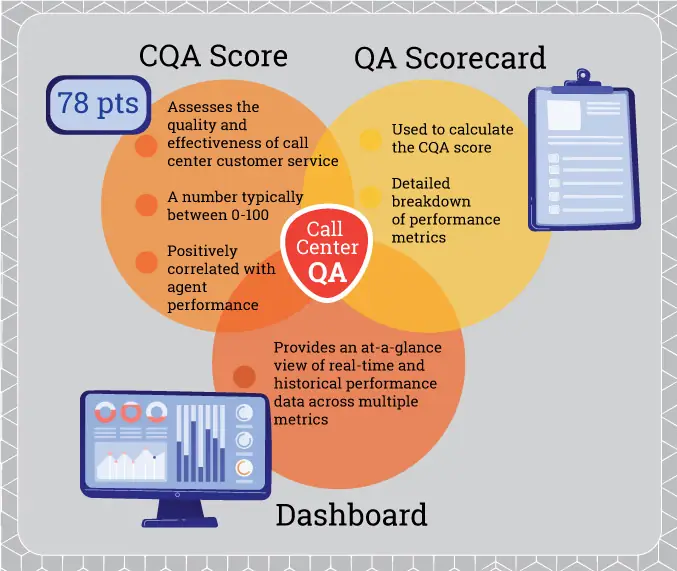
How Do These Tools Work Together to Ensure Quality Assurance?
While these tools serve different purposes, they work together seamlessly to ensure quality assurance in a call center. The CQA Score quickly assesses individual agent performance, while the QA Score Card objectively calculates the CQA Score based on weighted metrics. Meanwhile, the dashboard brings everything together, offering a comprehensive view of overall performance.
These three tools have pervasive impacts on agent performance and call center operations. They directly influence:
- Training and development – Scorecards and CQA scores help identify areas where agents need training and development.
- Performance management – Dashboard metrics assist in tracking and managing overall performance, identifying trends, and addressing bottlenecks.
- Decision-making – Together, these tools aid in making data-informed decisions about staffing, shifts, training, and procedural changes.
Request a mySQM™ Customer Service QA Demo Video
Learn about SQM's agent… CSAT prediction model, which is based on standardized metrics, AI, and regression analysis to predict customer satisfaction derived from a QA evaluation. Our CSAT prediction model provides a high statistical correlation, translating to a 95% success rate in predicting agent CSAT in most cases.
What Are the Best Practices for Utilizing the CQA Score, QA Scorecard, and Dashboard?
For every call center, enhancing quality assurance and tracking performance metrics are key goals that can help improve their service delivery. Here are some best practices for effectively using the CQA Score, QA Scorecard, and Dashboard.
Tips for Effectively Using CQA Score to Improve Quality Assurance
CQA score is a quantitative measure of agent performance that determines the quality of interactions between agents and customers. To get the most out of your CQA Score:
- Train your agents to focus on the areas with the highest weight in your CQA Score. For example, mySQM™ QA Score heavily emphasizes call resolution and customer satisfaction scores.
- Use the insights from your CQA Score to identify problem areas and coaching opportunities. For example, if an agent receives a low score in the call compliance category, they need to be re-trained on the laws and regulations that must be followed.
- Use the CQA Score to benchmark your agents' performance against each other to motivate agents to improve. For example, if an agent ranks 3rd or 4th among their team members, they will be motivated to improve their CQA score to get to 2nd or even 1st place.
Tips for Creating an Effective QA Score Card to Improve CX
The QA Score Card is a performance measurement tool that measures an agent's performance against set parameters. Here are ways to effectively create one for your call center:
- Determine your customer service QA goals and metrics to evaluate whether your agent and call center met your goals. For example, first determine your company goals (e.g., customer service, sales, call compliance), and then select the related metrics to evaluate whether your goals have been achieved (e.g., customer satisfaction score, call resolution, call compliance rating).
- Determine appropriate weighting for each of your customer service QA metrics. For example, 85% of the points in the mySQM™ QA scorecard are weighted toward customer service delivery and 15% toward call compliance.
- Decide on a customer service QA Scoring method. For example, SQM's customer survey uses a 4 or 5-point satisfaction scale for measuring agent customer service delivery. For call compliance metrics, it is common to use a binary scale where you can say yes or no, and 3 to 5-point scales are typically used when the metric is more subjective.
How to Make the Most of the Dashboard for Monitoring and Analyzing Data
The dashboard visually represents data and metrics, allowing efficient tracking and analysis. Follow these tips to use the dashboard optimally.
- Ensure all essential metrics are included in the dashboard for a comprehensive view. For example, ensure all the necessary KPIs are displayed or easily accessible for agents and supervisors.
- Keep the dashboard clear and understandable to avoid confusion and misinterpretations. For example, don't add unnecessary information to the dashboard because it will take away from the essential metrics.
- Use real-time data on your dashboard to make timely decisions and interventions. For example, CQA Scores and evaluations should be immediately displayed upon completion for the agents to view and help them understand their performance on the call.
